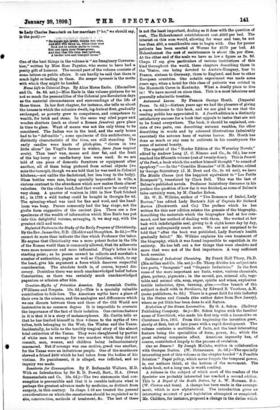Horne Life in Colonial Days. By Alice Morse Earle. (Macmillan
and Co. 8a. 6d. net.)—Miss Earle in this volume pictures for us not so much the personalities of the Colonial pre-Revolution days as the material circumstances and surroundings of the life of those times. In her first chapter, for instance, she tells us about the houses in which the colonists dwelt, log-huts at first, gradually exchanged, as poverty grew to competence, and competence to wealth, for brick and stone. In the same way oiled paper and wooden shutters (such as closed a Roman fenestra) gave place in time to glass. Want of means was not the only thing to be considered. The Indian was in the land, and the early house had to be " defensible "; some specimens of this architecture, so distinctly characteristic of the time, are still standing. The early candles were knots of pitch-pine, "cloven in two little slices" (so VirgiPs farmer in winter, fir-re faces inspicat acuto). Then bees'. wax, moose and deer fat, and the fruit of the bay-berry or candle-berry tree were used. So we are told of one piece of domestic furniture or equipment after another, all of them being pictured from actual objects (we miss the turn spit, though we are told that he was used in Colonial kitchens,—not unlike the dachshund, but less long in the body). Glass bottles were rare, being specially bequeathed in wills, a curious contrast to the abundance which now makes them almost valueless. On the other hand, food that would now be costly was very cheap. A quarter of venison in 1695 in New York fetched 9d.; in 1733 a wild turkey could be bought in Georgia for 4d. The spinning-wheel was used for flax and wool, and the hand. loom was busy. Purses commonly had the bag shape, not the girdle form suggestive of the ancient C4vn These are a few specimens of the wealth of information which Miss Earle has put into this delightful volume, arranging it, we may say, with the greatest skill and taste.


















































 Previous page
Previous page